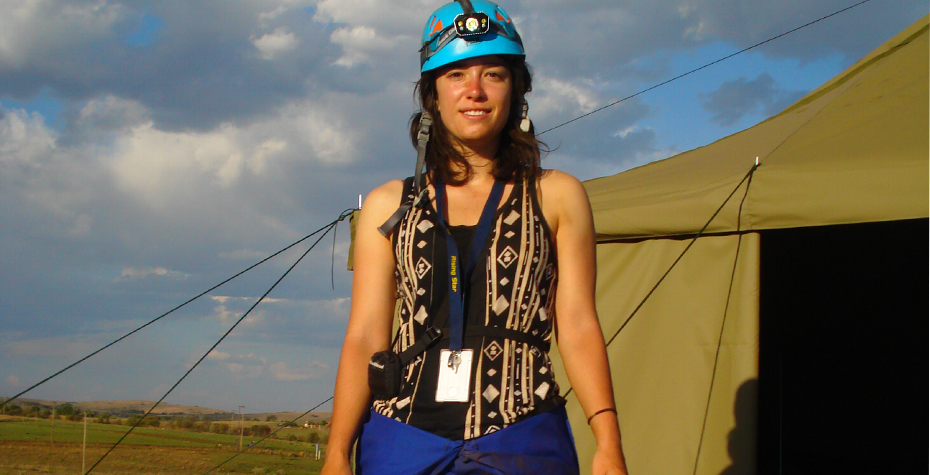Hundreds of Early Fossils Recovered by All-Female Team Promises to Illuminate History of Early Humankind

She might not wear a fedora, carry a bullwhip, or have a paralyzing fear of snakes, but archaeologist Alia Gurtov ’07 is giving Indiana Jones a run for his money as she participates in a once-in-a-lifetime expedition digging up hundreds of ancient fossils.
The eyes of those in the archaeological and anthropological worlds are fixed on the Cradle of Humankind caves outside Johannesburg, South Africa, as Gurtov and her five female colleagues carry out a history-making archaeological excavation, recovering hundreds of early hominin fossils that promise to illuminate the history of early humankind.
The adventure began in October when Lee Berger, a National Geographic Explorer-in-Residence and professor at the University of Witswatersrand in Johannesburg, organized a small exploratory team of cavers to search for fossils in remote sections of the Cradle of Humankind caves. The cavers discovered a cache of fossils buried deep in the "Rising Star" section of the caves. They shared their discovery with the world-famous paleoanthropologist, who then organized an expedition (christened the Rising Star Expedition) to recover the fossils.
Getting into the cave is incredibly difficult, with one dangerous section measuring only 18 centimeters (roughly 7 inches) wide. With this in mind, Berger sent out a call through social media for “experienced archaeologists of small proportions capable of dropping everything to come to South Africa for the month of November.”
Gurtov (third from right in photo) said that when she read Berger’s message, she and her current teammates all “shared the same reaction: Lee Berger is looking for me!”
Gurtov earned her master's degree in archaeology from Leiden University, Netherlands, and has worked and studied in Senegal, Tanzania, and South Africa; she is currently pursuing her Ph.D. in anthropology at the University of Wisconsin in Madison. Before she was a professional archaeologist, however, Gurtov majored in anthropology at Wellesley, taking courses in the same vein as Wellesley 207X: Introduction to Human Evolution.
“The education and mentoring I received at Wellesley College is the foundation for everything I’ve since accomplished in my career,” she said. “Phil Kohl, my adviser, encouraged me to apply for grants; arranged my field season at Dmanisi, Georgia; and gave me all the time and support I could have asked for. Wellesley as a whole provided the environment I needed to develop as a researcher, surrounded by active professors and devoted colleagues.”
Gurtov answered Berger’s call in October, and together with Lindsay Eaves, Elen Feuerriegel, Hannah Morris, Becca Peixotto, and Marina Elliot, won a spot on the expedition and arrived in South Africa in early November. The six excavators were joined by a team of scientists, cavers, volunteers, and supporters from the National Geographic, and joined online by thousands of people around the world who are following the project’s progress with high hopes of learning the secrets on the cave floor.
Gurtov described the first week of the expedition for us.
As I write, the sun is setting on day seven. We’ve fallen into a routine of sorts: breakfast at 6, briefing at 6:30, and the first team into the cave by 7:30. From there, we’re in our own subterranean world. The climb into the cave builds anticipation for the drop into the final chamber. The International Postbox is a squeeze through a space the size of two MRI compartments on end, followed by a jagged ascending ridge called Dragon’s Back. Once at the top, we stage ourselves until Lee Berger, the head of the Rising Star Expedition, gives us the green light to drop down the tight shaft into the hominin room. This final descent accounts for 90 percent of the bruises on our arms and legs, each one proudly earned. At this point, we six advanced scientists stand where few people have ever entered.
It wasn’t until the first time I entered the hominin chamber that the enormity of this discovery hit me and I had to take several deep breaths to keep from blurring my vision. The quantity of ancient human bones lying on the surface is enough to drop anyone’s jaw, including the hominin whose hemi-mandible we picked up first. Dr. Berger has described our careful tiptoeing around fossils as a moonwalk in low gravity.
As of this posting on November 25, Gurtov and her team have excavated over 1,000 hominid fossils, with untold numbers expected to emerge with time. The fossils are from multiple individuals of unclear age and species, both of which will require extensive study and analysis in order to determine.
The archaeological dig is fundamentally an expedition of discovery yet Gurtov says that there’s another, “equally important” purpose involved: reaching the next generation of scientists, especially girls. The National Geographic has promoted the expedition’s activities in a variety of ways, including organizing a Skype session with the archaeologists and a classroom of third graders in Rhode Island. “This is a tradition we hope to continue,” said Gurtov, “and we six scientists, women all, are looking for other opportunities to encourage girls and women to seek careers in science. This would be the greatest accomplishment.”
To keep updated on the Rising Star Expedition, read the National Geographic blog and follow Gurtov on Twitter @AGurtov, Lee Berger @LeeRBerger, and the hashtag #risingstarexpedition.
